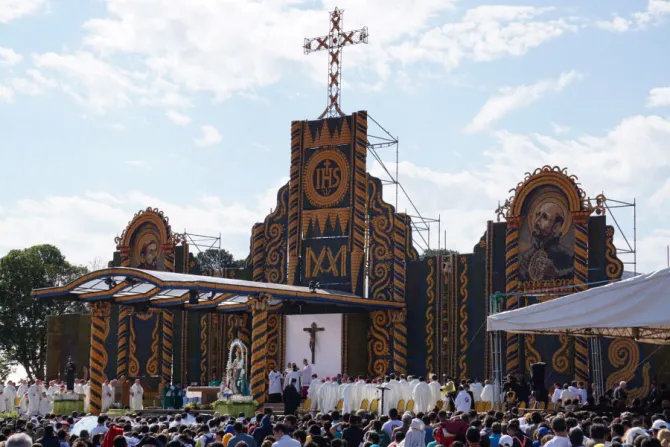Asunción, Paraguay, Jul 12, 2015 / 14:07 pm
The more than 60,000 corncobs, 20,000 squashes and 150,000 coconuts that adorn the altarpiece in Asuncion's Ñu Guazú park where Pope Francis celebrated Mass on the last day of his visit to Paraguay won't be going to waste.
Now that the Mass and the Pope have come and gone, the products will be recycled.
"The coconuts will be used to make soap and the corncobs are destined to feed animals. The squash will be given to people. From it, a sweet called 'andai' is made," the artist, Kiko Ruiz, told CNA days before the celebration.
"It's made me very happy to do this job. There's a great excitement among the people who collaborated with me in making the altar. This happiness motivated me to make this artwork," he said.
"I know that the Pope's visit has great significance because it's bringing happiness and a message of peace."
Ruiz is the plastics artist who was charged with the creation of the altar. The structure's base is 131 feet long and nearly 56 feet tall with a pyramidal shape. The total surface area is more than 4,305 square feet covered with corn, coconuts and squash. In the center, there's a cross.
On either side are mosaics, St. Francis on the left and St. Ignatius of Loyola on the right, in honor of the Franciscan and Jesuit missions that evangelized Paraguay. For this job, thousands of local seeds were used.
Ruiz worked with 20 other people on the design, while for the actual adornment of the altar, the numbers were boosted by 200 volunteers. Many of them found out about the work on social media and offered to help.
"With this work, I'd like to show that art is not exclusive to any inspired person. Art is in reach of everyone and it doesn't need anything strange, but normal everyday things, and what one produces can become a part of them," said Ruiz.
Aside from those who got their hands on the work, the artist explained that it was Paraguayan farmers who donated the fruits used in the altar. All of them knew that the products would be "valued and appreciated by the whole world," he said.
And the reaction was formidable. It was by far the most discussed part of the day on social media. A hashtag was even created on Twitter solely to speak of it: #altardemaiz, meaning "altar of corn."
For each square meter, 1,200 coconuts were used, and a special glue was made to stick them together. The 60,000 corncobs were tied to wooden bases.
The Guarani coconut is small and lasts up to 14 months. "It has a very hard shell that can be easily painted because when they peel them, they have a very smooth and hard surface. That's why you can draw on a coconut," Ruiz explained.
The coconuts were placed in the altar weeks prior to the July 12 Mass. When all the decorations were ready, a special ointment was applied that would preserve it from the elements and dirt.
The structure of the altar was built in modules to facilitate its decoration and transport. Ruiz, artisans and volunteers first built and decorated the pieces in Tañarandy, a part of San Ignacio Iguazu in Paraguay's Misiones.
Ruiz has done artistic work in the area for the last 23 years. His most recognizable pieces are the altarpieces for Holy Week celebrations that were also created with fruits of the earth.
The artist commented that the objective of these altars is to represent the nation's mixed culture as well as the Guarani culture.
"Two years ago we made the first altar where the culture mix of Paraguayan history with Baroque motifs was represented. It was adorned with the fruits of the earth that Guaranis used," Ruiz said.
"These fruits were corn, coconut and andais – we call it squash – and they were the most prized possession."


